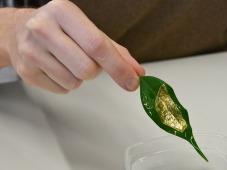Wraparound electronics
Researchers at ETH are developing electronics that can be wrapped around a single strand of hair. The development is expected to open up new possibilities for ultrathin, transparent sensors.
Scientists at Professor Gerhard Tröster’s Electronics Lab at ETH have been researching flexible electronic components, such as transistors and sensors, for some time now. They aim to weave these types of components into textiles or apply them to the skin in order to make objects ‘smart’, or develop unobtrusive, comfortable sensors that can monitor various functions of the body.
The researchers have now taken a big step towards this goal and their work has recently been published in the journal Nature Communications. With this new form of thin-film technology, they have created a very flexible and functional electronics.
Within a year, Münzenrieder, together with Giovanni Salvatore, has developed a procedure to fabricate these thin-film components. The membrane consists of the polymer parylene, which the researchers evaporate layer by layer into a conventional two-inch wafer. The parylene film has a maximum thickness of 0.001 mm, making it 50 times thinner than a human hair. In subsequent steps, they used standardised methods to build transistors and sensors from semiconductor materials, such as indium gallium zinc oxide, and conductors, such as gold. The researchers then released the parylene film with its attached electronic components from the wafer.
An electronic component fabricated in this way is extremely flexible, adaptable and - depending on the material used for the transistors - transparent. The researchers confirmed the theoretically determined bending radius of 50 micrometres during experiments in which they placed the electronic membrane on human hair and found that the membrane wrapped itself around the hair with perfect conformability. The transistors, which are less flexible than the substrate due to the ceramic materials used in their construction, still worked perfectly despite the strong bend.

Münzenrieder and Salvatore see ‘smart’ contact lenses as a potential area of application for their flexible electronics. In the initial tests, the researchers attached the thin-film transistors, along with strain gauges, to standard contact lenses. They placed these on an artificial eye and were able to examine whether the membrane, and particularly the electronics, could withstand the bending radius of the eye and continue to function. The tests showed, in fact, that this type of smart contact lens could be used to measure intraocular pressure, a key risk factor in the development of glaucoma.
However, the researchers must still overcome a few technical obstacles before a commercially viable solution can be considered. For instance, the way in which the electronics are attached to the contact lens has to be optimised to take into account the effects of the aqueous ocular environment. In addition, sensors and transistors require energy, albeit only a small amount, which currently has to be provided from an external source. “In the lab, the film can be easily connected to the energy supply under a microscope. However, a different solution would need to be found for a unit attached to the actual eye,” says Münzenrieder.
Professor Tröster’s laboratory has already attracted attention in the past with some unusual ideas for wearable electronics. For example, the researchers have developed textiles with electronic components woven into them and they have also used sensors to monitor the bodily functions of Swiss ski jumping star Simon Ammann during his jumps.
A lighter, smarter magnetoreceptive electronic skin
Researchers have developed an innovative e-skin that facilitates a new level of interaction...
Single transistor used to implement neuromorphic behaviour
Researchers have demonstrated that a single transistor can mimic neural and synaptic behaviours,...
Novel fabrication technique for flexible electronics
Researchers have harnessed nature's intrinsic hierarchical fractal structures to improve the...





